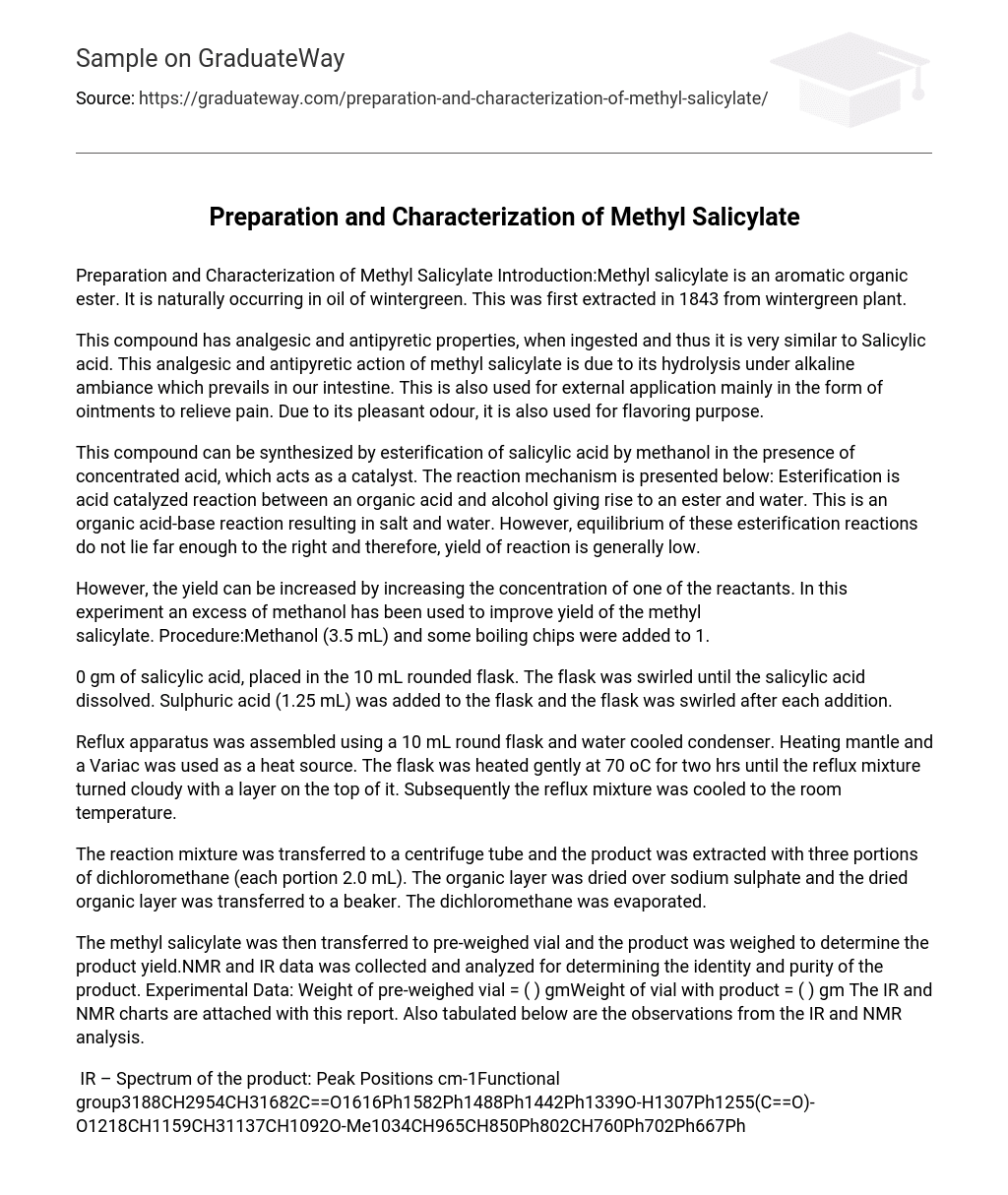Preparation and Characterization of Methyl Salicylate Introduction:Methyl salicylate is an aromatic organic ester. It is naturally occurring in oil of wintergreen. This was first extracted in 1843 from wintergreen plant.
This compound has analgesic and antipyretic properties, when ingested and thus it is very similar to Salicylic acid. This analgesic and antipyretic action of methyl salicylate is due to its hydrolysis under alkaline ambiance which prevails in our intestine. This is also used for external application mainly in the form of ointments to relieve pain. Due to its pleasant odour, it is also used for flavoring purpose.
This compound can be synthesized by esterification of salicylic acid by methanol in the presence of concentrated acid, which acts as a catalyst. The reaction mechanism is presented below: Esterification is acid catalyzed reaction between an organic acid and alcohol giving rise to an ester and water. This is an organic acid-base reaction resulting in salt and water. However, equilibrium of these esterification reactions do not lie far enough to the right and therefore, yield of reaction is generally low.
However, the yield can be increased by increasing the concentration of one of the reactants. In this experiment an excess of methanol has been used to improve yield of the methyl salicylate. Procedure:Methanol (3.5 mL) and some boiling chips were added to 1.
0 gm of salicylic acid, placed in the 10 mL rounded flask. The flask was swirled until the salicylic acid dissolved. Sulphuric acid (1.25 mL) was added to the flask and the flask was swirled after each addition.
Reflux apparatus was assembled using a 10 mL round flask and water cooled condenser. Heating mantle and a Variac was used as a heat source. The flask was heated gently at 70 oC for two hrs until the reflux mixture turned cloudy with a layer on the top of it. Subsequently the reflux mixture was cooled to the room temperature.
The reaction mixture was transferred to a centrifuge tube and the product was extracted with three portions of dichloromethane (each portion 2.0 mL). The organic layer was dried over sodium sulphate and the dried organic layer was transferred to a beaker. The dichloromethane was evaporated.
The methyl salicylate was then transferred to pre-weighed vial and the product was weighed to determine the product yield.NMR and IR data was collected and analyzed for determining the identity and purity of the product. Experimental Data: Weight of pre-weighed vial = ( ) gmWeight of vial with product = ( ) gm The IR and NMR charts are attached with this report. Also tabulated below are the observations from the IR and NMR analysis.
IR – Spectrum of the product: Peak Positions cm-1Functional group3188CH2954CH31682C==O1616Ph1582Ph1488Ph1442Ph1339O-H1307Ph1255(C==O)-O1218CH1159CH31137CH1092O-Me1034CH965CH850Ph802CH760Ph702Ph667Ph NMR Spectrum of the product Chemical Shift (ppm)PatternIntegrationAssignmentProton10.79singlet1HydroxyOH7.82doublet1Ar HH3 or H67.44triplet1Ar HH4 or H56.
98doublet1Ar HH3 or H66.87triplet1Ar HH4 or H53.92singlet3MethylCH3Discussion:The peaks of IR spectrum of the reaction product were labeled as per the Verghese H. T.
(2006). This spectrum shows IR absorption peaks corresponding to all the functional groups in methyl salicylate. This confirms that the product could be the desired product.The findings of IR spectrum analysis were confirmed from NMR analysis of hydrogen.
NMR analysis shows peak corresponding to hydrogen present at aromatic ring, in the methyl group and in the hydroxyl group. The peak corresponding to 10.79 ppm corresponds to hydroxyl group; the peak in 6 – 8 ppm range correspond to hydrogen at the aryl ring and peak at 3.92 ppm belongs to the three hydrogen atoms at the alkyl group.
Thus, these two analyses confirm synthesis of methyl salicylate in this experiment. Conclusion:The experiment was intended to synthesize methyl salicylate using esterification of salicylic acid by methanol in the presence of acid and isolating the product from the reaction mixture. The reaction proceeded on expected line and the extracted reaction product was investigated using IR spectroscopy and NMR. The reaction product was confirmed to be the desired product from these analyses.
It can be therefore, concluded that the esterification of salicylic acid by methanol resulted in synthesis of methyl salicylate and the same was extracted successfully from the reaction mixture. References:Verghese H. T., Panicker C.
Y., Philip D., Mannekutla J. R.
and Inamdar S. R. “IR, Raman and SERS studies of methyl salicylate” Spectrochimica Acta Part A 66 (2007) 959–963





